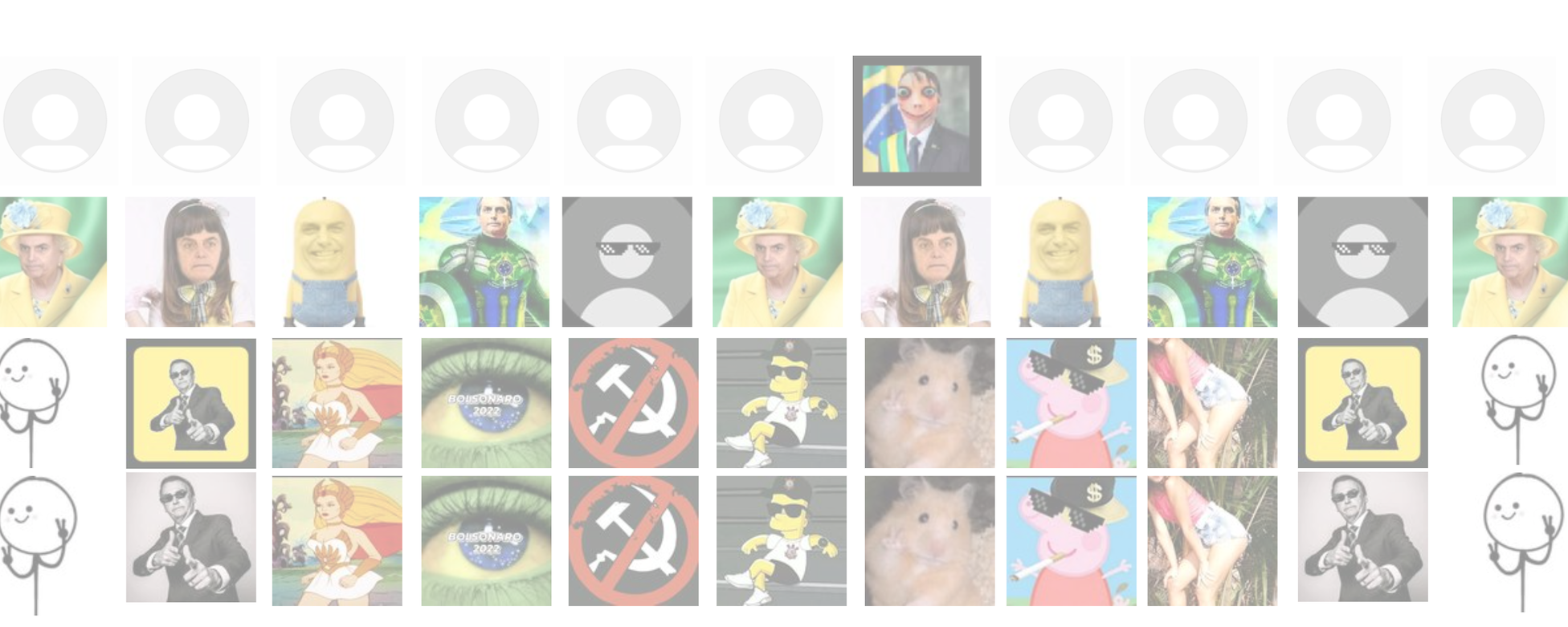Blog post by Emillie de Keulenaar, Francisco Kerche, Giulia Tucci, Janna Joceli Omena and Thais Lobo [alphabetical order] *This text was originally posted on the Public Data Lab webpage: https://publicdatalab.org/2022/05/05/profiling-bolsobot-networks/
Brazilian political bots have been active since 2014 to influence elections through the creation and maintenance of fake profiles across social media platforms (Pereira, 2022). In 2017, bots’ influence and forms of interference gained a new status with the emergence of “bot factories” acting in support of Jair Bolsonaro’s election and presidency. What we call bolsobots are inauthentic social media accounts created to consistently support Bolsonaro’s political agenda over the years, namely Bolsonaro as a political candidate, President, and avatar of a conservative and militaristic vision of Brazilian history, where social discipline, Christian values and a strong but economically liberal state aim to uproot the decadent influence of “socialism” (Messenberg, 2019). From viralising or spreading hashtags to establishing target audiences with pro-Bolsonaro “slogan accounts” with a strong, visual presence, these bots have also been tied to documented disinformation campaigns (Lobo & Carvalho, 2018; Militão & Rebello, 2019; Santini, Salles, & Tucci, 2021). Despite the efforts of social media platforms, including Whatsapp and Telegram, to restrict their more or less coordinated inauthentic activities (Euronews, 2021), bolsobots still exist and actively adapt to online cultures.
Accounting for the upcoming Brazilian 2022 elections, the project Profiling Bolsobots Networks investigates the practices of pro- and anti- Bolsonaro bots across Instagram, Twitter and TikTok. It aims to empirically demonstrate how to capture the operation of bolsobot networks; the types of accounts that constitute bot ecologies; how (differently) bots behave and promote content; how bolsobots change over time and across platforms, pending to different cultures of authenticity; and, finally, how platform moderation policies may impact their activities over time. In doing so, the project will produce a series of research reports on “bolsobot” networks and digital methods recipes to further the understanding of bots’ presence and influence in the communication ecosystem.
We are (so far) a group of six scholars collaborating on this project: Janna Joceli Omena (Public Data Lab / iNOVA Media Lab / University of Warwick), Thais Lobo (Public Data Lab / King’s College London), Francisco Kerche (Universidade Federal do Rio de Janeiro), Giulia Tucci (Universidade Federal do Rio de Janeiro), Emillie de Keulenaar (OILab / University of Groningen) and Elias Bittencourt (Universidade do Estado da Bahia). Below are some of the preliminary outputs of the project.
Method
How do we detect bolsobots across platforms?
Quali-quanti methods support our approach to detecting bolsobots, following an ethnographic perspective combined with digital methods research (account analysis). We account for both the technicity and usage culture of the platforms where bolsobots act and exist, also observing the agency of these accounts in the platform environment. This project traces and detects Instagram and TikTok bolsobot accounts by first looking at their username patterns (see Omena, 2017; Wilson, 2017), then verifying the name account stats and profile visual settings (e.g. type of image profile and publications, whether it is a public or private account). We created search queries considering platform-specific affordances and combining thematic keywords with the name “Bolsonaro” (or related names supporters call Bolsonaro, such as “mito” [legend]). The choice of keywords aligns not only with fieldwork observations but also with well-described categories of Bolsonaro supporters (see Kalil, 2019). As for Twitter, we capture bots using an issue-oriented hashtag list to collect first relevant tweets, and then run a bot detection algorithm, Botometer (Yang, Varol, Hui, & Menczer, 2020), to find potential bots over time. Twitter accounts are thus checked with a high (or low) probability of being inauthentic based on their behaviour or characteristics as, for instance, fake followers, spammers, echo chambers or astroturfers. A higher score means a more inauthentic behaviour. This is not to say that the user is necessarily a bot, but that they tend to behave like one, or have tended to do so at some point in their activity history. Below is a diagram summarising our bot detection technique (Figure 1).
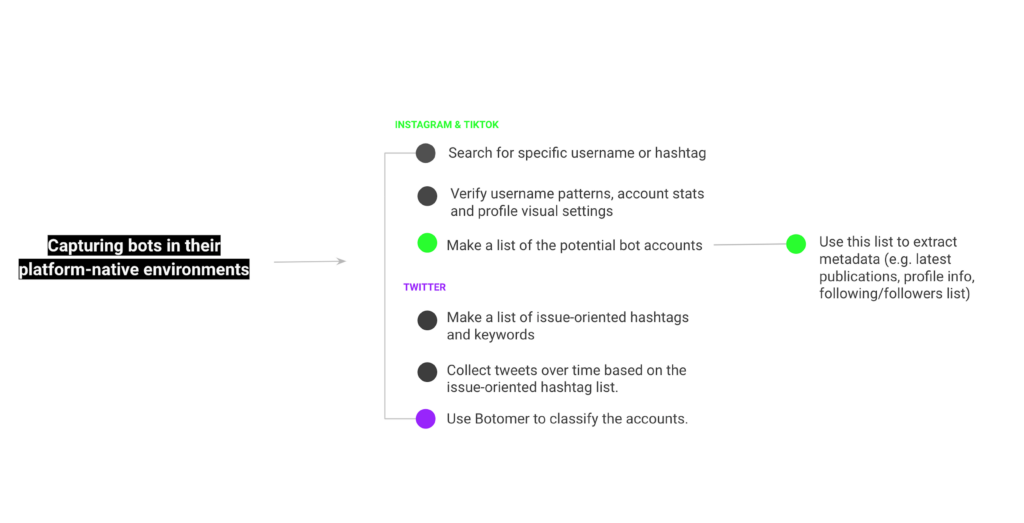
By profiling bolsobots networks with quali-quanti digital methods, the project also suggests an innovative methodological framework to study inauthentic behaviour online that moves beyond bot detection towards an analysis of their vernacular, collective strategies and particularities.
Bot taxonomy and vernaculars
What do Instagram & TikTok bolsobots look like?
Bolsobots create their presence on Instagram and TikTok in a strategic way (see examples on the image and gif below), following bot practices such as the creation of similar usernames for a range of accounts. In their account usernames, they add up to Bolsonaro’s name different agendas such as political campaign (bolsonaro.presidente.2022), LBGT movement (bolsonaristagay) and ironic far-right leaning keywords (bolsonaroopressor, meaning “bolsonarotheoppressor”). In their account profile pictures, bolsobots use photos of the Brazilian president as an emphatic, likeable and memetic persona, sidelining otherwise controversial or more extreme political stances. Flattering representations of Bolsonaro are present in every major theme of our datasets, such as patriotism, family and religion values, conservatism, alternative news media, LGBT community and memes. Brazilian flags or colours and minions are other frequent visual styles adopted in bolsobot profile pictures (Figures 2a and 2b). They, for example, transform critical characterizations of Bolsonaro supporters as “minions” – the small, yellow characters of the computer-animated movie Despicable Me – into slogans, calling themselves bolsominions, i.e., sycophantic followers who proudly obey their boss. Popular oppositions to Bolsonaro created the term “bolsominion” during Bolsonaro’s presidential campaign in 2018 to insult or characterise his supporters, who started using the term as a phrase of self-description and adoration (see the complete case study about bolsominions bots here).
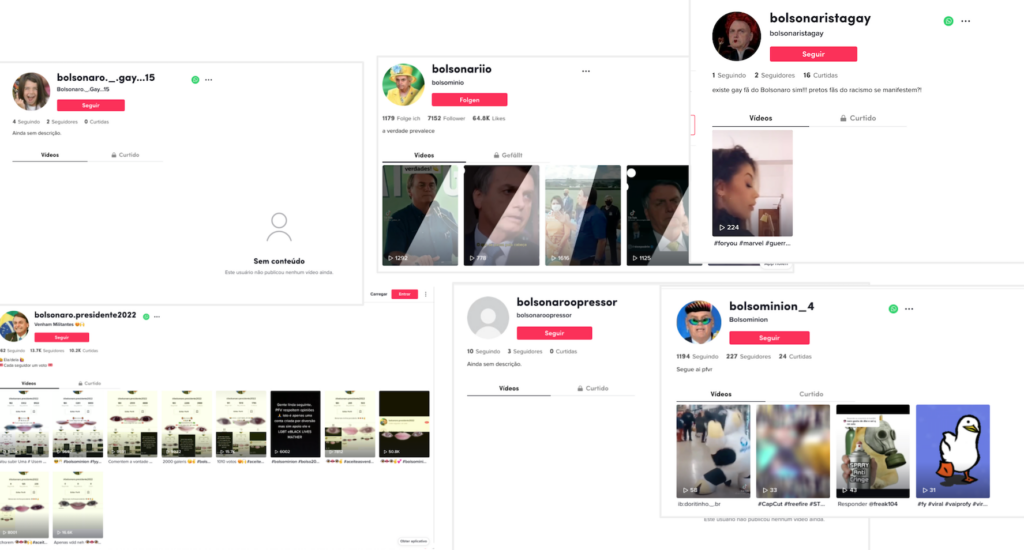
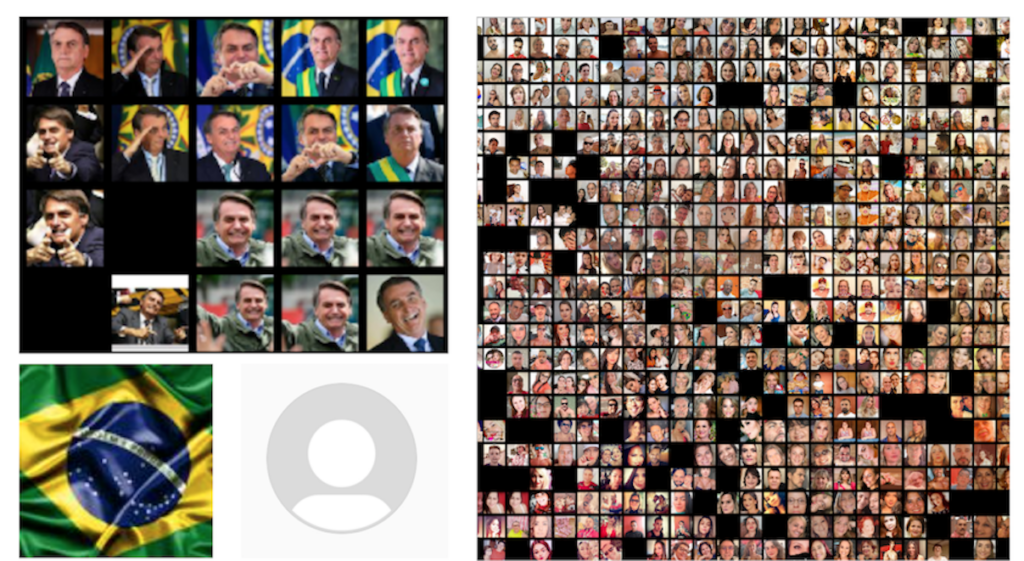
Figures 2a and b. Examples of profile images of bolsobots accounts on TikTok (top) and Instagram (bottom).
As ordinary bot accounts, bolsobots also incorporate private or public profiles without profile pictures while using fake human image profiles. We call these profiles “ghost accounts”. For example, in the image above, we see the profile picture of bolsobots commenters who quickly reacted to an Instagram post. Our findings on TikTok bolsobots show at least 10% of bot accounts use a coloured initials icon image (we have found a lot of letters ‘B’ in our sample) or use a ghost account-like picture (see the bolsobots profiles screenshots GIF below). Although not significant in quantity, ghost accounts are purposefully created to like, comment and follow — and unfollow — other accounts (see our DMI project report from 2019), yet remain present in Instagram and TikTok bot ecosystems (see the Good Enough Publics report).
A final example of what bolsobots look like is their memetic visuals, not restricted to versions of bolsominions. Below, the gif visualisation is divided into three different bolsobots image profile maps, in which the size of images responds to the number of TikTok followers. From top to bottom, besides the overwhelming visual presence of Bolsonaro himself and bolsominions, we see other memes – for example, Bolsonaro as the Queen of England, the Joker, a white woman, or an anime character (Figure 3).

We estimate that these accounts have been created in preparation for the Brazilian presidential elections of the fall of 2022, and remain quietly online, without attracting much scrutiny, merely contributing to building content, accumulating engagement numbers and keeping Bolsonaro’s presence alive and positive across platforms.
How do bolsobots operate across platforms?
As fake publics, bolsobots target and engage with specific conservative agendas, as well as LGBT and feminist discourses. They operate on the basis of mainstream and discrete bot accounts (Omena et al., 2021). The former are accounts that generate content, gathering substantial numbers of followers, which are in turn created by the latter: a diverse range of discrete bots spreading different discourses supportive of the Brazilian president. When operating in discrete modes, bolsobots mimic real people, use private accounts and establish profiles without pictures (i.e, ghost accounts) to comment and like content generated by their mainstream counterparts.
Instagram & TikTok
The way bolsobots operate on Instagram and Tik Tok is by creating a visual presence and “slogan accounts” with repetitive usernames. They thus integrate Bolsonaro’s political, social and cultural agendas (e.g. patriotism, family and religion, conservatism, alternative news media, LGBT community and memes) and lexicon such as bolsonarista, patriota (“patriot”), fechado com bolsonaro (“I’m sticking to Bolsonaro”), opressor, bolsolinda (“beautiful Bolsonarista”). Some examples of account names as “political slogans” are fechadocombolsonaro45, bolsonaro22opressor, presidente_bolsonaro and bolsonaropresidente.2022. Another example is repetitive usernames containing the word “bolsominion”, shown in the GIF below, which illustrates how bolsobots echo pro-Bolsonaro slogans on the platform (Figure 4). We found that the Bolsominons (as memetic bots) and ghost accounts (as discrete bots) permeate across all agendas and topics.


Figure 4. Bots repetitive usernames containing the word “bolsominion”. Source: https://smart.inovamedialab.org/editions/2022-discussing-methods-making/project-reports-2022/bolsobots
Bolsobot ghost accounts act as bridging nodes, connecting with political, governmental and traditional conservative media entities to emulate the behaviour of real accounts. In the networks below, we used two techniques to spot the presence and role of the bolsobots ghost accounts on Instagram. First, by visually detecting their presence (pink nodes) in different zones of the bipartite network (centre, bridging clusters and periphery) (Figure 5a). Second, in the monopartite network, we identified that ghost accounts are central targets to pro-bolsobots (Figure 5b). Here, we face another discrete and particular mode of bot operation.
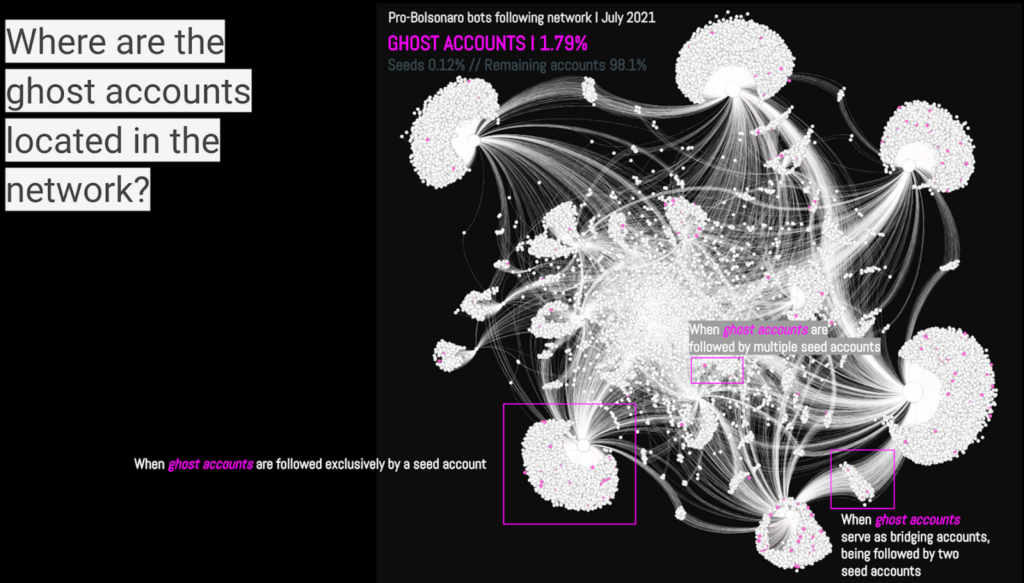

When it comes to mimicking authentic users, bolsobots are somewhat laborious and sophisticated. They adopt, for example, the Brazilian stereotype of an older, religious, and conservative female and their typical online behaviours. This can be seen with “auntie bots”, whose messaging style steers away from spreading political information or propagandising the government. Instead, “auntie bots” resort to religious symbols, hearts, and flowers as a form of conservative symbolism (read the case study here). Such operative modes move from the stereotypical portrayal of bots as “beautiful females” to the deliberate adoption of contextually suitable socio-digital identities. As a result, determining whether or not these users are bots becomes more challenging.
How do Bolsobots act on Twitter?
Bolsobots are responsible for a significant amount of pro-Bolsonaro content on Twitter. Using bot-detection tools such as Botometer, we can see that over 44% of tweets belong to users with a high probability of being bots (66-100% bot-like activity). This wide range of tweets consists of name-dropping (by using multiple mentions (@) to bring attention to a given post), to spreading hashtags associated with a specific movement or narrative. For example, a typical profile with a high botometer score mentions an average of 5.5 users and 2.6 hashtags per post.
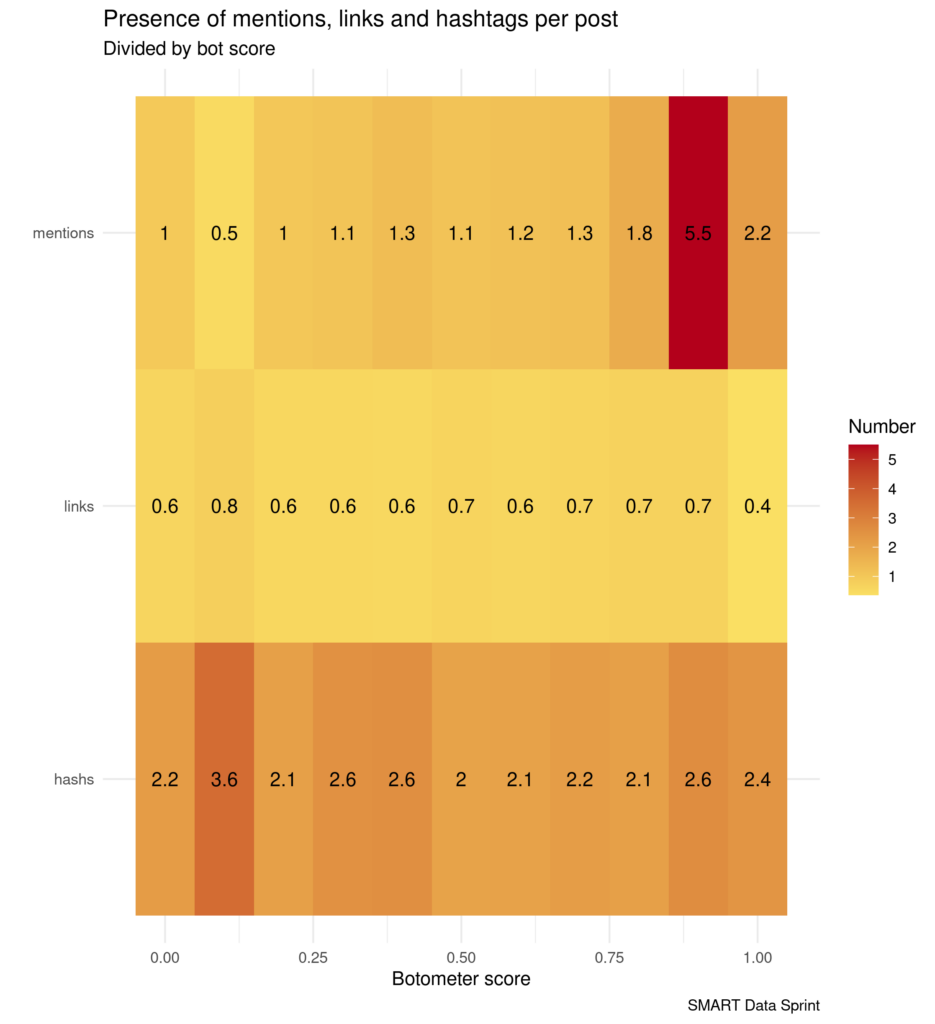
Twitter bolsobots are not only responsible for making “noise” on the platform by replying and retweeting a lot of content. They are also creators of original content that is replied to and spread out by regular users and bots. This is the case with recent bot activity peaking in 2021, which saw the creation of new bots to launch new hashtags and showcase massive support for Bolsonaro (Figure 6).
How have Twitter bolsobots changed over time?
Using a historical dataset of about 900 tweets containing the same (or similar) issue-related hashtags as now, we have records of bolsobots active on Twitter since at least 2015. To assess how or whether they have changed, we processed their Botometer scores in two distinct periods (May of 2020 and February of 2022) and observed their behaviour over time, namely: how much they retweet and reply to others, who they retweet and reply to, how many and which hashtags they spread, and whether or not they post original content over time.
We find that Twitter bolsobots have been most active in three specific periods: (1) the 2018 elections; (2) the end of 2019, when Bolsonaro left his political party and his son, Flavio, became the target of investigations for the rachadinha corruption scandal; and (3) the 2022 elections, in which some online pre-campaigns, like those of Bolsonaro and ex-President Lula, started by December 2021 (Figure 7). In this sense, we find that bots were most active when Bolsonaro’s political career was most at risk. This artificial support would not only encourage additional authentic support, but also grant him and his government democratic (rather than institutional) legitimacy. Indeed, as bot tweets peaked by the end of 2021, they arguably laid the groundwork for his online presence in the coming 2022 elections. We speculate that there are a smaller number of bot tweets in 2018 and 2019 because, as we have found in previous research, many of them had been deleted in the context of legal investigations against fake news in early 2019.
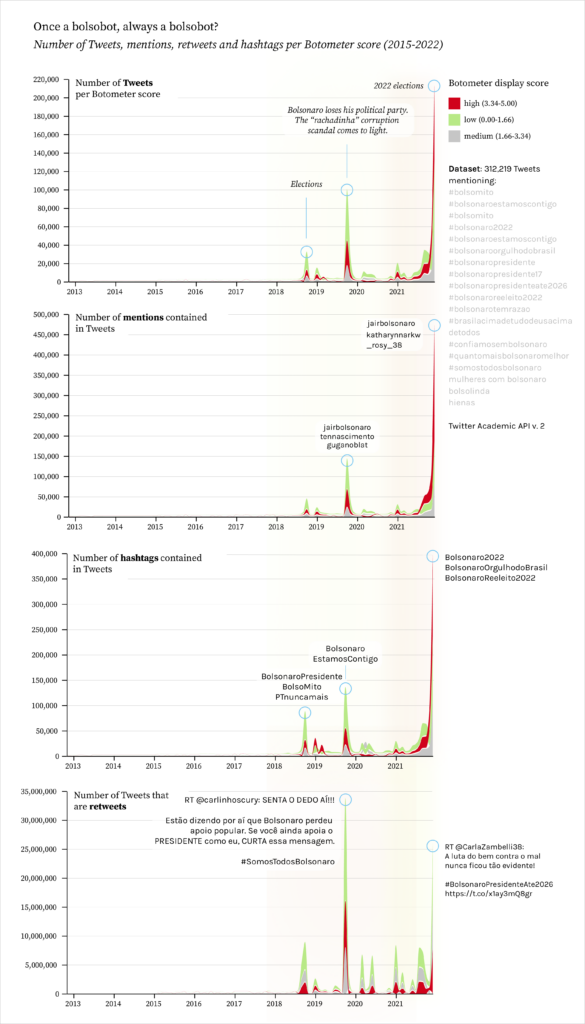
We also see that the role of Twitter bots on Twitter changed significantly since 2015, in that they are increasingly creating more original content. This marks a shift from bots as mere “relayers” of original content. To demonstrate this, we counted the number of times a hashtag was first used, as well as the user publishing it (Figure 8). The average bolsobot user has shifted from a 0.65 botometer score (65% of bot-like behaviour) in 2018 to 0.79 in 2021. In this period, bots or bot-like profiles were increasingly more responsible for igniting the spread of a given hashtag. 75% of hashtags were created from users with a score higher than 0.6, while in the previous year, they were only responsible for half of the new hashtags.
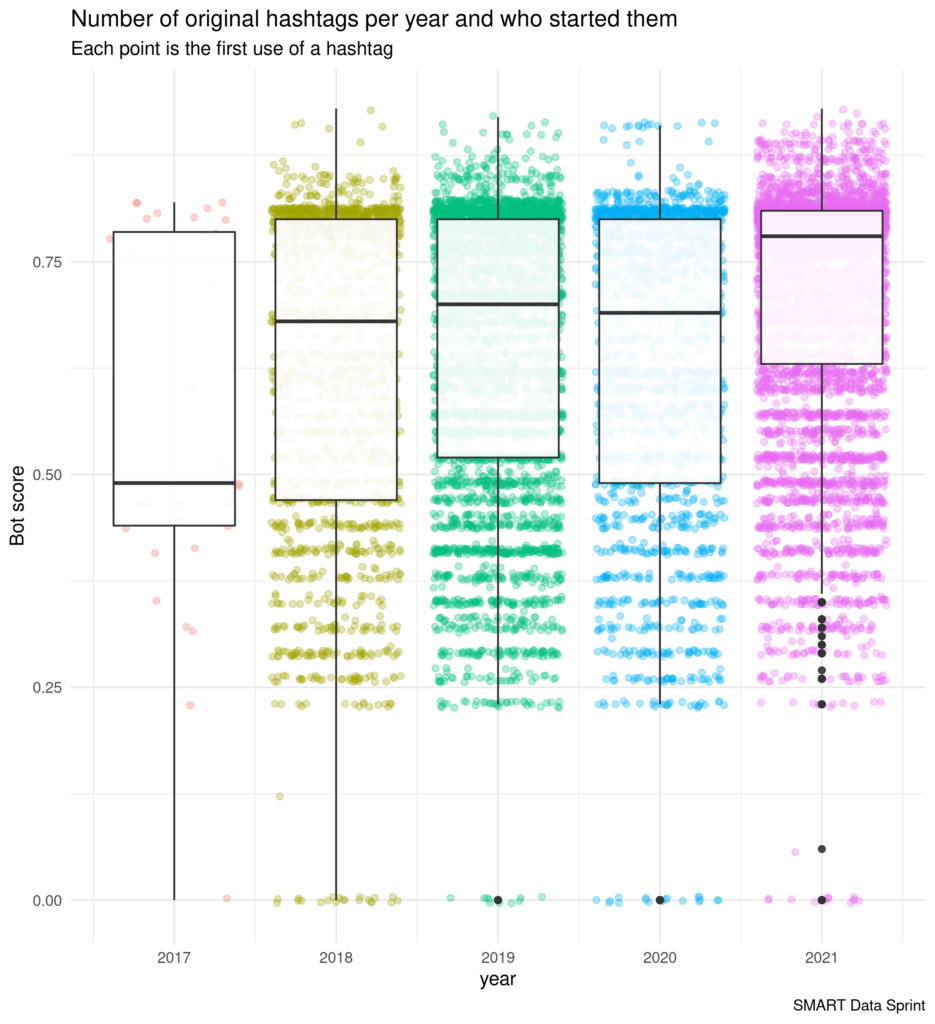
Such hashtags are not as well established as those from users with a minor botometer score. By looking at the difference between the first and last days of publishing a given hashtag, it is possible to see that the higher the botometer score, the lower the average lifespan a hashtag has (Figure 9). In other words, bolsobots are good content creators, especially with regards to the speed and variety with which they publish their content. The impact of their content is however not as lasting as that of more organic users.
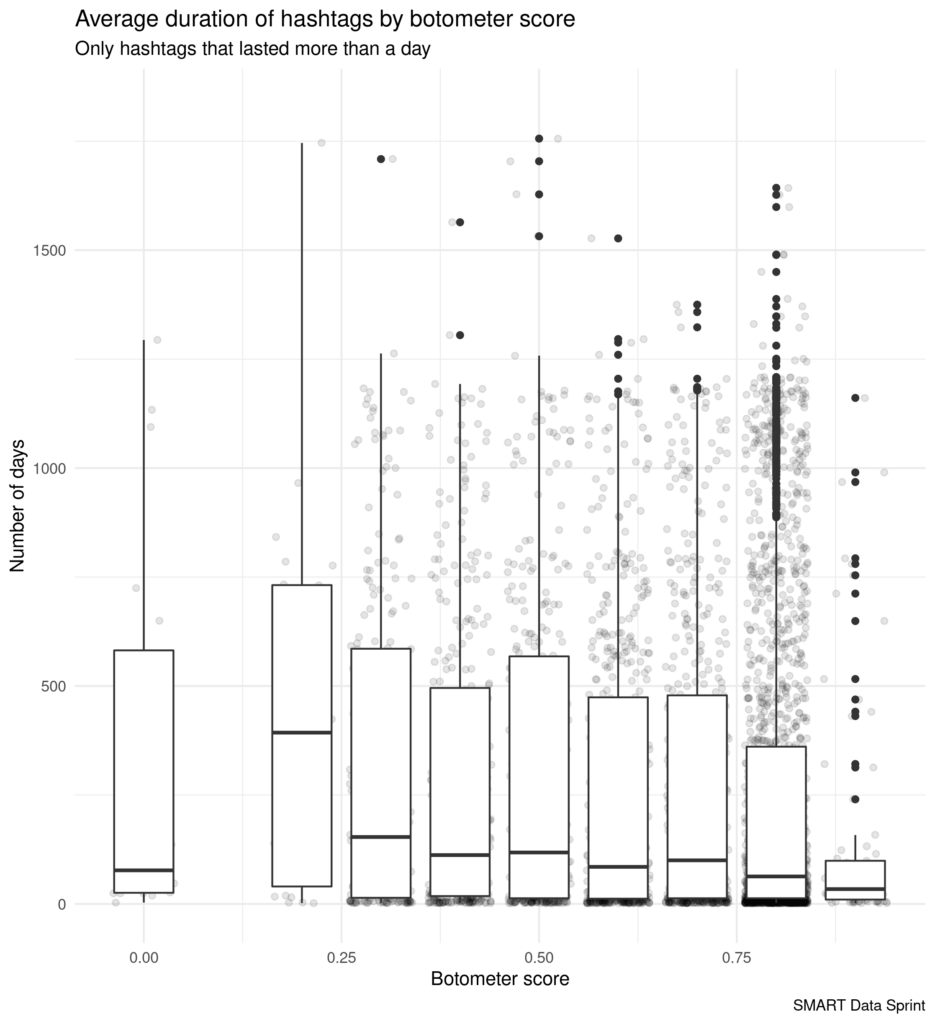
We have also found that newly posted hashtags have in fact been recycled from previous years (Figure 10). In other words, creating a bot vernacular takes time and a repertoire of political action. In this sense, we could argue that botometer hashtags are rather general rather than context-specific . We see in fact that in 2021, bolsobots were surprisingly skilful at combining hashtags from all previous years, particularly those from 2019, after which they created a great number of new ones.
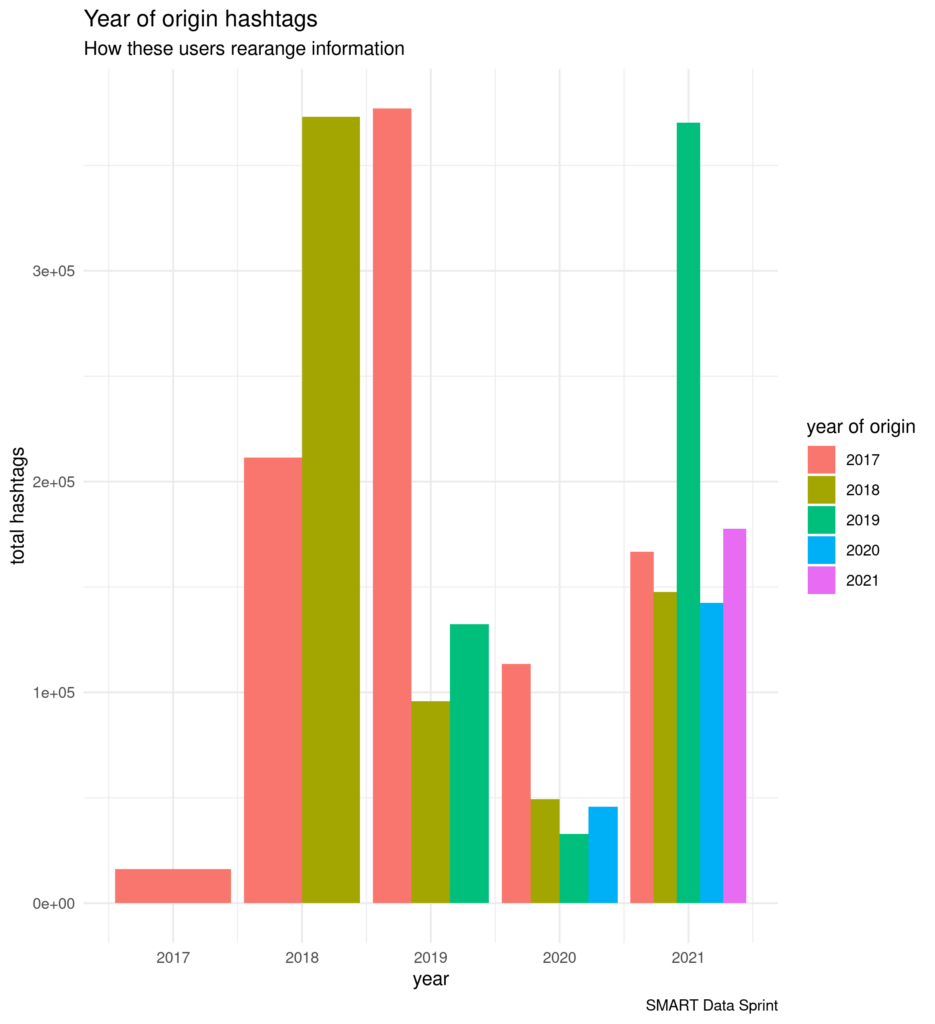
Perhaps the most significant change we observed was the way in which bots identified or presented themselves in the face of public scrutiny against fake news and coordinated inauthenticity. Bolsonaro, and more specifically his son Carlos, have been the target of numerous legal, journalistic and public investigations for allegations of artificially inflating his father’s campaigns online with inauthentic means, be they disinformation campaigns or inauthentic users. The most serious of these allegations were made by an ex-ally of Bolsonaro’s, Joyce Hasselman, who alleged that Carlos headed a cabinet designed to target opponents of Bolsonaro and his government (the so-called “gabinete do ódio”, or “cabinet of hate”). In response, authenticBolsonaro supporters — that is, users with low Botometer scores — began to defy allegations claiming they were in fact bots (Figure 11). Conversely, “real” bots — users with high botometer scores — claimed they were not bots.

Summarising these results, we see that those accusing Bolsonaro supporters of being “bolsominions” or bots are mostly authentic, as were, until late 2020, those claiming (or “counter-claiming”) they were bolsominions and bots. From late 2021, however, we see that the large majority of users claiming not to be bots became in fact bots (Figure 11, 12).

When we break down Botometer scores by bot type scores — that is, the specific behaviors that Botometer detects in a user before classifying them as bots — we find that those claiming not to be bots or bolsominions act as traditional bots, in that they consist mainly of being fake followers, spammers, or self-declared bots. Those that are not bots but claim to be so behave largely as echo chambers, despite having an overall poor botscore (Figure 13). This finding goes in line with our larger conclusion that authentic users embody cultures of inauthenticity as a form of political allegiance, of hyper-partisanship, confirmed by their high echo chamber scores. Conversely, users who are bots seek to model themselves after authentic users, but can only go so far as replicating or aggregating their original content.

Conclusion: a “post-bot” era?
In conclusion, we find that bolsobots have not only changed their strategies over time, but also been subject to a larger change in the overall cultures and conceptions of authenticity in Brazilian political infospheres.
Though still somewhat idle, TikTok bolsobots have consisted of laying the groundwork for the upcoming elections of fall 2022. Ghost and slogan accounts, for example, consist of marking a presence of pro-Bolsonaro content in a newly adopted platform in the Brazilian social media ecosystem — one that is yet to be subjected under the same level of legal scrutiny as Telegram, Facebook, Instagram or Twitter. This strategy relies on the visual influence of slogan profile pictures, memes and other images that largely subscribe to the broad policy areas of Bolsonaro’s government: family values, militarism, conservatism, and even an appropriation of traditionally liberal social issues (LGBT and feminism).
Bolsobots have a longer history on Twitter, particularly under the public eye of journalists, legislators and opposition politicians accusing Bolsonaro of running disinformation-fuelled campaigns. There, we see that while bolsobots have traditionally consisted of relaying content from authentic users — hashtags, tweets — they have since 2021 started to produce more “original” content by aggregating (or “recycling”) a unique ensemble of authentic hashtags. We also see that they have become the first users to begin spreading new hashtags.
Most importantly, we see that both TikTok and Twitter users partake in an important change in the overall culture of authenticity of Brazilian political infospheres. In the face of more public scrutiny against online inauthenticity, inauthentic users have tried to act more authentic, by for example producing “fresher” content on Twitter or TikTok, or even denying that they are bots. Conversely, authentic users appropriate inauthenticity as a form of political loyalty for Bolsonaro — in other words, they assume the automated aspects of loyalty and partisanship as an ultimate form of authenticity.
This short history of bolsobots pushes us to reconsider traditional conceptions of bots, as formulated at the wake of the U.S. “fake news” debacle of 2016-2018. While these early conceptions define bots as synonymous with automation — i.e., users who lack original content, are predictable and work in repetitive patterns — we see that bots have actively answered to these ideas, transforming themselves into what bot detection algorithms, fact checkers and content moderation suspect them of not being. Authentic users, on the other hand, have adopted much of the behavior of bots — repetitive, sycophantic and responsible for much unoriginal content — as a form of authenticity in its own right. This goes to show how research methods for the study of misinformation must continuously adapt to the very phenomenon they seek to understand. As we change our ideas about what is and isn’t authentic, so must we change the methods we use to study it.
References
Euronews. (2021). Fake news fear as Bolsonaro bids to limit social media content removal. Retrieved April 1, 2022, from Euronews website: https://www.euronews.com/2021/09/07/fake-news-fear-as-bolsonaro-bids-to-limit-social-media-content-removal
Kalil, I. (2019). Who are Jair Bolsonaro’s voters and what they believe. Center for Urban Ethonography. https://doi.org/10.13140/RG.2.2.35662.41289
Lobo, T., & Carvalho, D. (2018). Robôs e desinformação nas redes: O que já se sabe nas eleições 2018. Retrieved April 1, 2022, from Nexo Jornal website: https://www.nexojornal.com.br/ensaio/2018/Rob%C3%B4s-e-desinforma%C3%A7%C3%A3o-nas-redes-o-que-j%C3%A1-se-sabe-nas-elei%C3%A7%C3%B5es-2018
Messenberg, D. (2019). A cosmovisão da “nova” direita brasileira. In R. Menezes (Ed.), Brasil em transe: Bolsonarismo, nova direita e desdemocratização (p. eBook). Rio de Janeiro: Oficina Raquel.
Militão, E., & Rebello, A. (2019). Rede de fake news com robôs pró-Bolsonaro mantém 80% das contas ativas. Retrieved April 1, 2022, from UOL website: https://noticias.uol.com.br/politica/ultimas-noticias/2019/09/19/fake-news-pro-bolsonaro-whatsapp-eleicoes-robos-disparo-em-massa.htm
Omena, J. J. (2017). Insta Bots and the black market of social media engagement. Retrieved April 27, 2022, from Janna Joceli Omena website: https://thesocialplatforms.wordpress.com/2017/12/21/insta-bots-and-the-black-market-of-social-media-engagement/
Omena, J. J., Lobo, T., Tucci, G., Kerche, F. W., Paschoal, M., JI, X., … Huang, S. (2021). Profiling Bolsobots Networks. A quali-quanti approach to repurpose Instagram grammars. Digital Methods Initiative. Retrieved from Digital Methods Initiative website: https://wiki.digitalmethods.net/Dmi/SummerSchool2021BolsobotsNetworks
Omena, J. J., Lobo, T., Kerche, F., Tucci, G., Keulenaar, E. de, Liedtke, M., … Gouveia, F. (2022). After all, what are bolsobots like these days? Retrieved April 27, 2022, from #SMARTDataSprint website: https://smart.inovamedialab.org/editions/2022-discussing-methods-making/project-reports-2022/bolsobots/
Pereira, L. A. (2022). The hate machine: How Bolsonaro makes use of algorithmic knowledge. Retrieved April 27, 2022, from Diggit Magazine website: https://www.diggitmagazine.com/articles/bolsonaro-algorithmic-knowledge
Santini, R. M., Salles, D., & Tucci, G. (2021). When Machine Behavior Targets Future Voters: The Use of Social Bots to Test Narratives for Political Campaigns in Brazil. International Journal of Communication, 15(0), 1220–1223.
Wilson, C. (2017, April 6). I Spent Two Years Botting on Instagram—Here’s What I Learned. Retrieved April 27, 2022, from PetaPixel website: https://petapixel.com/2017/04/06/spent-two-years-botting-instagram-heres-learned/
Yang, K.-C., Varol, O., Hui, P.-M., & Menczer, F. (2020). Scalable and Generalizable Social Bot Detection through Data Selection. Proceedings of the AAAI Conference on Artificial Intelligence, 34(01), 1096–1103. https://doi.org/10.1609/aaai.v34i01.5460
